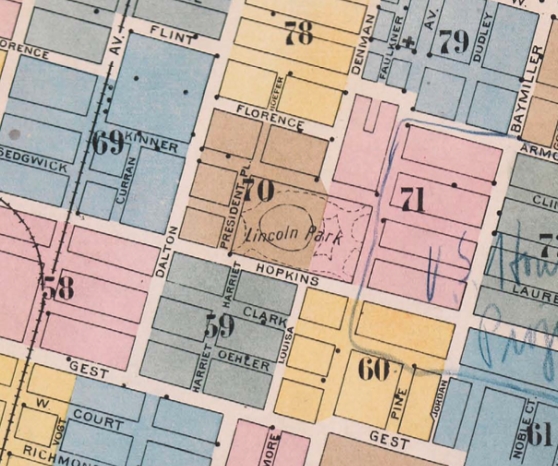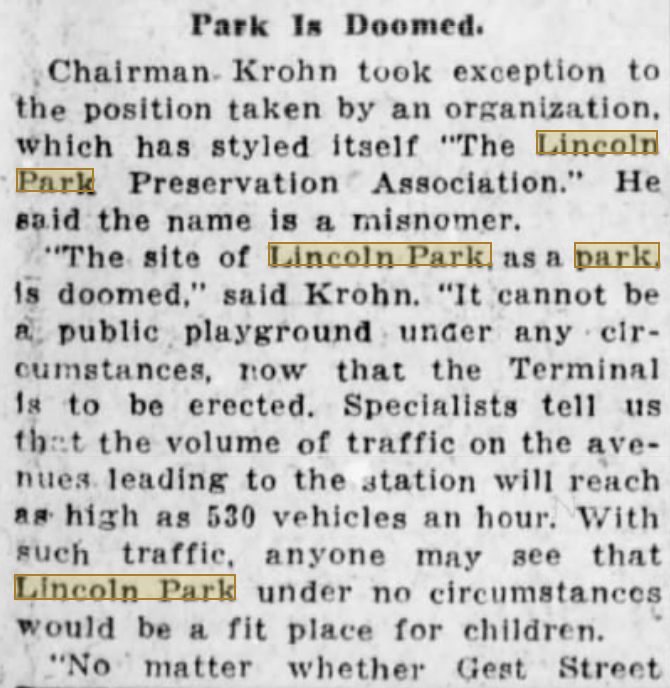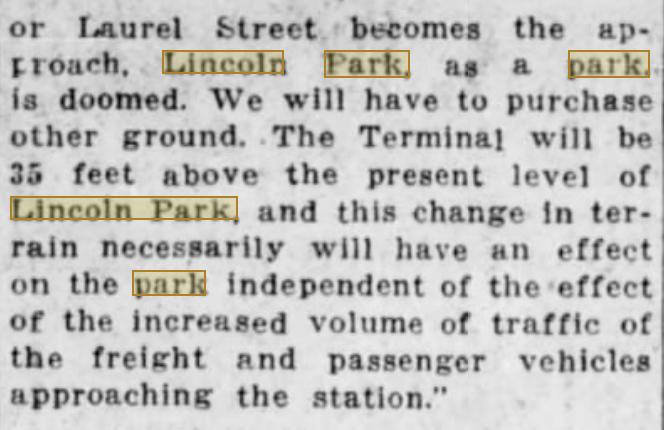Recently, I was looking at old Sanborn Maps of my neighborhood (the West End) and came across something interesting called Lincoln Park. It caught my eye because as far as I knew, Lincoln Park did not currently exist. It also caught my eye because it reminded me of present-day Washington Park, a popular green space in the nearby OTR neighborhood that sees thousands of visitors and hosts dozens of events every year. Since I knew Lincoln Park didn’t currently exist, I couldn’t help but wonder what happened to it?
Lincoln Park in 1904. The Public Library of Cincinnati and Hamilton County
Closer view of the west section of Lincoln Park in 1904. The Public Library of Cincinnati and Hamilton County
Closer view of the east section of Lincoln Park in 1904. The Public Library of Cincinnati and Hamilton County
Lincoln Park in 1906. Library of Congress
For those who aren’t familiar with the West End neighborhood of Cincinnati, it was the site of a huge urban renewal project that started in 1958 called Kenyon-Barr. The Kenyon-Barr project displaced almost 30,000 people, most of whom were black. The intention of the project was to build I-75 and a new industrial neighborhood called Queensgate. I recently wrote about the project. My initial assumption was that Lincoln Park was caught in the collateral damage of the Kenyon-Barr project, and the site of the park was claimed by I-75. I went to Google Maps to try and locate where the park used to be.
The Kenyon-Barr project resulted in many streets in the West End either being destroyed or renamed, so comparing locations in the neighborhood before urban renewal to present-day can sometimes be disorienting. Fortunately, several of the streets that bordered Lincoln Park (Hopkins Street, Dalton Avenue, and Kenner Street) still exist today and I was able to locate where Lincoln Park used to be. Imagine my surprise when the location turned out to be the parking lots of Union Terminal! Union Terminal was built 25 years before the Kenyon-Barr project started, so I knew I-75 had nothing to do with the disappearance of Lincoln Park. Now I needed to figure out why Union Terminal was built on top of such a beautiful park!
The red rectangle shows the approximate location of where Lincoln Park used to be. Google Maps
In the early 20th century, Cincinnati was a huge train hub for the country. It had several train stations along the Ohio River, but they were prone to flooding. Eventually the city of Cincinnati realized flooding and train stations the economy depended on didn’t mix well, so it was decided to try and build a new train hub. This new train hub would be big enough to consolidate all of the existing train stations, and far enough from the river so that it wouldn’t be affected by flooding. This new train hub was Union Terminal. The location chosen for Union Terminal was ideal because it was far enough away from the Ohio River, and there were rail lines already running through the area. Unfortunately the location wasn’t ideal for Lincoln Park, because Union Terminal would be located just west of it. Additionally, city leaders expected Union Terminal to see a large volume of automobile traffic, and would need big enough roads leading up to the station to handle said traffic. This essentially signaled the demise of Lincoln Park and resulted in a lot of fighting among city leaders, because Lincoln Park was a popular attraction and many wanted it saved. This newspaper excerpt from 1929 shows then Chairman of Cincinnati’s Park Board essentially delivering an eulogy for Lincoln Park, because in one way or another Union Terminal would change it forever:
Cincinnati Enquirer, October 1929
So it seems like Lincoln Park was a cool park that had the misfortune of standing in the path of one of the most important train stations of the 20th century, and that is why it no longer exists. That’s essentially what happened. When Union Terminal was originally built the city tried to preserve as much of Lincoln Park as it could and used what was left as a greenspace for the station’s entrance, but over the years it eventually faded away into a parking lot. However, here’s where things get even more interesting - in the newspaper clipping, Chairman Krohn mentions purchasing “other ground.” Was another park created to replace Lincoln Park? Yes! It turns out Laurel Park (a few blocks east of Union Terminal), was built as a replacement for Lincoln Park. The best part is that Laurel Park still exists today!
The West End in the 1950s. You can see the remnants of Lincoln Park that were converted into green space, before the parking lots were built. University of Cincinnati libraries
The red rectangle shows where Laurel Park is located today. Google Maps
So we finally know what happened to Lincoln Park. It was a beautiful park with a lake and island that was eventually reduced to nothing more than parking lots and a road. What would Cincinnati look like if Lincoln Park still existed in 2020? Laurel Park was intended to be Lincoln Park’s replacement, but it lacks most of the amenities Lincoln Park had (for example: it doesn’t have a lake with a cool island). Washington Park is one of the most popular parks in the city, and something interesting I found in my research is that Lincoln Park (18 acres) was actually a lot bigger than present-day Washington Park (6 acres). I can’t help but wonder if Lincoln Park would have exceeded present-day Washington Park’s popularity if it still existed. Would present-day West End be as vibrant as present-day OTR if it had a gathering place like OTR does Washington Park?









